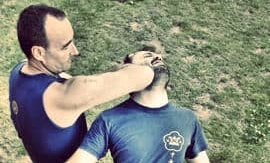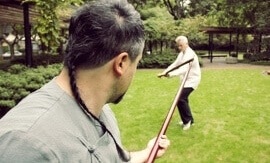
WE SAT DOWN TO TALK WITH THE CHAIRMAN OF THE FATSAAN WING CHUN ASSOCIATION, MASTER GWOK WAI JAAM, TO DISCUSS ITS BACKGROUND, MISSION AND FUTURE INITIATIVES.
Please tell us something about the background of the formation of the Fatsaan Wing Chun Association?
In the past, there was great unrest here in Fatsaan among the Wing Chun community. There was a lot of conflict between the different schools and lineages, and challenge fights were a rather common occurrence in those times. So, because of this situation, the various Sifus was very restrictive with their teachings, and wouldn’t share and discuss their knowledge and experience with peers—a practice which was detrimental to the development and retard the growth of Wing Chun.
Then, in 2012, a group of seniors of the local Wing Chun community sat down and established a formal organisation, the Fatsaan Wing Chun Society, which is a subsidiary of the Fatsaan Wushu Association. Initially, we had less than 20 schools under our banner but due to our efforts, this number had risen to over 120 in 2017. Also, because of the increased administrative burden and workload, we established the Fatsaan Wing Chun Association as an independent organisation, officially sanctioned by the Fatsaan government, the following year. Currently, our members exceed 190 schools.
What’s the purpose and the goal of this association and what’s “traditional” Wing Chun?
Our purpose and mission are to create unison, harmony, friendship and cooperation among the different factions of traditional Wing Chun practitioners. Besides protecting and preserving the traditional Fatsaan style of Wing Chun (the styles descending from Leung Jan, Law Man Gung and Fung Siu Ching), but also to develop it and make it relevant in modern times.
The way to achieve this is through establishing a common standard for what exactly traditional Wing Chun is, harmonisation of teaching methods and curriculums, etc. Of course, this hasn’t been easy since the various branches/schools are far from a homogenous group.
Basically, we define “traditional” Wing Chun as the art as to how it was passed on to us from our ancestors—without the modifications younger generations of practitioners have made, such as adding footwork from other styles, borrowing and applying theories and ideas alien to the system, say from Tai Gek Kuen, Western Boxing, Muay Thai, Wrestling, etc.
How does the association develop and promote the art?
The first step was to bring the elite of all families together to pool our knowledge and experience, to learn from each other, and together decide what’s the best way to develop and promote Wing Chun. We then established several “task forces” or “sub-departments”, each with their responsibilities to focus on the different important tasks to realise our purpose. For example, one department is charged with planning and performing demos to properly demonstrate “traditional” Wing Chun. Also, to showcase the various schools’ unique flavour and skills, we have one team from each lineage of Wing Chun.
Another example is the “Research and Development Center”, which is responsible for studying the traditional fighting techniques and their practical application and gathering historical information. Then, there is the “Practical Application Training Base” where students train specifically to apply traditional Kung Fu skills and techniques when facing modern fighting systems. Of course, there’s also a management department, etc.
In terms of promotion, our focus at this time is on competitions and establishing a Duan Wai (grading) system for our association. Competitions are an excellent way to provide practitioners of traditional Kung Fu with a venue to test and apply the techniques and fighting concepts they have learnt. It’s also a great way to motivate practitioners to train more goal-oriented and to develop their Kung Fu skills. Younger generations like to challenge themselves, to test their skills, to compete, so we hope that competitions will be a way to generate greater interest in traditional martial arts among them.
The purpose of the grading system is to ensure that teachers in our organisation understand what “traditional” Wing Chun is and have the theoretical knowledge and practical skills to teach it.
Could you explain to our readers about the competition format?
Based on our definition of “traditional” Wing Chun we have designed a competition format that allows for the application and development of the traditional Wing Chun skills and techniques. The ultimate goal is to demonstrate that traditional Kung Fu is a practical and viable fighting method, even today.
Currently, there are four disciplines in which contestants can showcase their skills: Forms, Chi Sau, “Skilled Counter” and Full-Contact Fighting. Regarding the forms category, after thorough discussion amongst specialists from the major branches, a general set of basic requirements were established based on the principle to maintain the traditional ways. Regarding Chi Sau competitions, it hasn’t been easy to reach a consensus about a set of rules because of the high variability in the various methods employed by the different lineages.
Over the past years, we have held more than a dozen Chi Sau competitions in Fatsaan. After each event, we reflected on the experience and constantly worked on making adjustments to improve. For example, in the early competitions there was a lot of wrestling, pushing, and application of techniques and ideas from other styles such as Western Boxing and even Tai Gek Kuen. Since the goal is to develop the “traditional” Wing Chun as an effective fighting method, we have banned such techniques—only the traditional techniques such as Laan, Gaan, Bong, Taan, Fook, etc. are accepted. Also, a technique must be solid, with enough “threatening power” to score a point—light, insubstantial slaps or taps do not count.
In reality, the situation where one can continuously stick and control the opponent’s arms occurs very rarely. Also, to create a bridge between Chi Sau and actual full-contact free fighting, we created a category called “Skilled Counter”. Fundamentally, this is the same as the Chi Sau category, however, the range of targets has been expanded (competitors can strike the head, for example) as have the number of techniques, which are allowed (kicking). Finally, there is full-contact free fighting. This has even fewer restrictions on what techniques can be used, how they can be used, and what areas are legal targets.
Our idea is that once our traditional style fighters have built up enough full-contact free fighting experience, they go out to compete in other, non-traditional events and can effectively apply their traditional fighting skills in those contexts.
Safety is very important to us, so another function of the Duan Wai system is to ensure that contestants have the required level of training to compete at different levels. Thus, one has to have achieved a certain level within our grading system to compete in different categories.
Won’t the special characteristics and unique features of the various branches of Wing Chun suffer if a general standard is implemented?
When we talk about harmonisation and standardisation of teaching methods and such, we don’t mean that we want to create a new generic style everyone has to do. Quite the opposite! Preserving each lineage’s specialities and unique features is at the heart of the premises of our association. It simply means we agree on what the core of “traditional” Wing Chun is and ensure this is taught in our membership schools.
In a similar vein, we don’t wish to create certain standard or official “competition versions” of forms and techniques that Wing Chun practitioners must learn to participate in the competition. As long as the established fundamental requirements are met, everybody can compete and demonstrate their style’s characteristics.



















